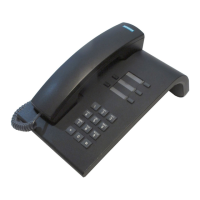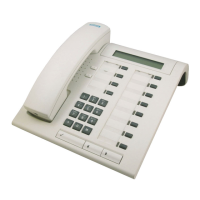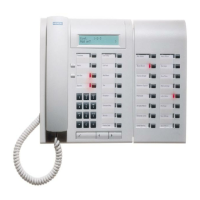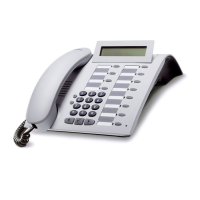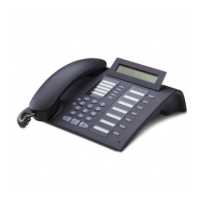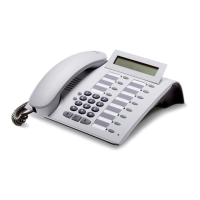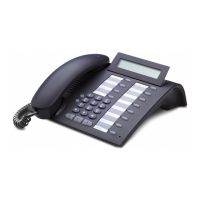Do you have a question about the Siemens Optiset E Advance Plus and is the answer not in the manual?
Provides introductory information and context for using the manual.
Explains how to interpret the symbols and structure used in the operating instructions.
Details how prompts and functions are displayed on the telephone screen.
Confirms the device conforms to EU guideline 1999/5/EG.
Details manufacturing in accordance with ISO 14001 for energy efficiency.
Explains how to select functions directly from the idle telephone.
Details using the Program/Service menu to access function lists and codes.
Describes how to access saved functions directly by pressing programmed keys.
Covers standard functions accessible via screen, menu, or keys.
Details functions for team collaboration and executive/secretary roles.
Provides tips for faster dialing and managing busy lines.
Step-by-step guide to answering incoming calls using the handset.
Instructions for answering calls using the speakerphone mode.
Allows other people in the room to join an active call.
How to switch an active call from handset to speakerphone mode.
How to switch an active call from speakerphone back to handset mode.
Explains how to handle incoming calls while already on another call.
Steps to accept an incoming call when another call is active.
How to enable or disable automatic signaling of a second incoming call.
Option to suppress or enable the audible tone for waiting calls.
Procedure to answer a specific ringing call intended for a colleague.
How to reject calls that you do not wish to take.
Accessing and managing messages stored in the telephone's mailbox.
How to set up timed reminders for scheduled events.
Instructions for using the speakerphone for calls and announcements.
How to enable or disable the automatic handsfree answerback feature.
Procedure for answering calls when a headset is connected.
How to activate or deactivate the Do Not Disturb feature.
Enables or disables the telephone's ringer for incoming calls.
How to identify anonymous external callers by tracing the call.
Temporarily switches the handset or speakerphone microphone off.
How to communicate with visitors at the entrance and operate the door opener.
Procedure to open the door using a code from the keypad or transmitter.
How to accept calls from a connected answering machine.
Shows the number of waiting calls and indicates system overload.
Steps to dial numbers after lifting the handset.
Steps to dial numbers using speakerphone or other on-hook methods.
Allows entering numbers before dialing and correcting them.
Prevents your station number or name from appearing on external displays.
How to make loudspeaker announcements to internal users.
Enables transmission of DTMF signals for device control.
Automatically establishes a connection to a preset internal or external destination.
Allows reserving a busy trunk line for exclusive use.
Selectively assigns a specific number (DID) for external calls.
Sends a signal to trunks to activate ISDN services or features.
Using a dialing aid connected via S0 bus or a/b port, or the telephone itself.
How to call a second party while keeping the first party on hold.
Seamlessly switching between the primary party and a held party.
Instructions for setting up and managing conference calls with multiple participants.
How the initiator can add more participants to an ongoing conference.
How the initiator can check the list of current conference participants.
How the initiator can remove participants from a conference call.
Procedure for a participant to leave an ongoing conference call.
How the initiator can end an ongoing conference call.
How to transfer an active call to another colleague or destination.
Announcing an ongoing call to a group of users for transfer.
How to temporarily park a call to be picked up later from another phone.
Steps to retrieve a call that has been previously parked.
How to place an external call on hold, allowing others to retrieve it.
Steps to retrieve an external call that has been placed on hold.
How to view and manage a list of incoming and outgoing calls.
Steps to access and browse the telephone's caller list.
Procedure to exit the caller list viewing mode.
View call time, date, station number, or name from the caller list.
How to redial a number directly from the caller list.
How to delete specific entries from the caller list.
How to save an external party's number to the caller list for redial.
How to redial the last three external numbers dialed.
How to view and dial stored station numbers.
How to find and dial numbers from the internal telephone directory.
How to use programmed keys for quick dialing of saved numbers.
How to use station and system speed-dial numbers.
Shows call charges at the end of a call or continuously.
How to display and print chargeable calls for other telephones.
Assigning external calls to specific projects using account codes.
Stores a callback request to be notified when a busy line becomes free.
Steps to store a callback request when a line is busy or unanswered.
What happens when a saved callback request is triggered.
How to view, check, and cancel previously stored callback requests.
Details the process of camp-on when a line is busy.
Allows joining a busy internal call with alerting tone for participants.
How to set the volume level for incoming call rings.
How to select and adjust the sound of the incoming call ring.
Sets volume for attention rings for team calls while busy.
Optimizes speakerphone performance based on room acoustics (Quiet, Normal, Noisy).
How to adjust the volume of the received audio during a call.
How to swivel the display unit for better screen readability.
How to change the language displayed on the telephone screen.
Prevents unauthorized use of the telephone and its notebook.
How to save a personal identification number for security and access.
How to save frequently dialed numbers to programmable keys.
How to save station numbers for quick dialing using speed-dial codes.
How to assign various telephone functions to programmable keys.
Explains the meaning of LED indicators for various saved functions.
Details LED indications for trunk keys and functions without LEDs.
How to save a sequence of operating steps (procedure) to a single key.
How to activate stored procedures by pressing a key.
How to save appointments to receive call reminders.
How to delete or check previously saved appointments.
Procedure to test all telephone functions and confirm their operation.
How to verify which functions are programmed on specific keys.
How to forward internal or external calls to different destinations.
Steps to turn off active call forwarding.
How to forward all external calls to a specific internal telephone during non-business hours.
Forwarding calls within the carrier network using assigned multiple subscriber numbers (MSN).
How to send short text messages to other system users.
How to view and delete text messages that have been sent.
How to receive and view incoming text messages.
How to leave a message on the screen for internal callers when away.
How to remove advisory messages from the telephone screen.
Allows others to use your telephone as if it were their own for outgoing calls.
Procedure to change your telephone's call number and settings to another phone.
How the key indicates received faxes or answering machine messages.
Performs a general reset to cancel all activated functions for the telephone.
Allows joining an ongoing call to listen in unnoticed.
Enables monitoring of a room by activating a telephone for listening.
Turns functions on/off for other telephones via associated service.
Locks or unlocks other telephones to prevent unauthorized access.
Accesses system functions and activates/deactivates features from outside the system.
Lists functions accessible via DISA and their respective codes.
How to access ISDN functions using code dialing on the keypad.
Control connected computers or programs like hotel services via telephone.
Turns up to four relays on/off to control facilities like door openers.
Detects signals from sensors, causing phone to ring and display messages.
Contacting people via pocket receivers through the paging system.
How to be paged and answer pages with simple equipment.
How to use enhanced paging equipment for contacting parties.
Steps to answer a page from the nearest telephone.
How team members use trunk keys to access shared telephone lines.
Explains the meaning of LED lights on trunk keys.
How to answer incoming calls using the trunk keys.
How to initiate outgoing calls using available trunk keys.
How to place a call on hold using a trunk key and retrieve it later.
How to switch between active calls on different trunk lines.
How to forward internal or external calls on individual lines.
Deactivating call forwarding and understanding Forward Line key LED indications.
How to use DSS keys to directly reach other team members.
Explains the meaning of LED lights on DSS keys.
How to answer incoming calls using DSS keys.
How to call a team member directly using their selection key.
How to transfer a call in progress using DSS keys.
How to accept calls on behalf of another team member.
How to join or leave group calls.
How to transfer calls directly to the executive's telephone.
How to activate or deactivate audible signals for group calls.
How to join or leave hunt groups and group calls.
How to turn audible tones on/off for specific groups or all groups.
How to accept calls for another team member, even while busy.
How to set up calls to ring on multiple internal phones.
How calls are distributed to agents based on break times.
How agents log on and off for their shifts in UCD.
How agents set their availability (Available/Not Available) during a shift.
Temporarily removes phone from call distribution for focused work.
Activates or deactivates night service for UCD.
Shows the current number of calls waiting in the queue.
How to leave hunt groups or group calls within the LAN environment.
Activate/deactivate call forwarding for your phone from other HiPath AllServe phones.
Define other HiPath 3000 phones as night answer points via LAN.
Set up calls to ring on multiple phones via LAN.
Control relays in other HiPath 3000 platforms via LAN.
Activate the door opener in other HiPath 3000 platforms via LAN.
How to use supplied cards to label fixed and programmable keys.
Using PC software to conveniently label telephone keys.
How to attach station number labels to the telephone.
Information on how to order additional copies of the operating instructions.
How to download operating instructions from the Internet.
Details on available accessories to customize the telephone.
Descriptions of various accessories like phone adapters, headsets, and microphones.
Guidelines for cleaning and maintaining the telephone.
Solutions for common problems like unresponsive keys or no ring.
Explains common error messages and how to resolve them.
Information on who to contact for persistent or unresolved problems.
